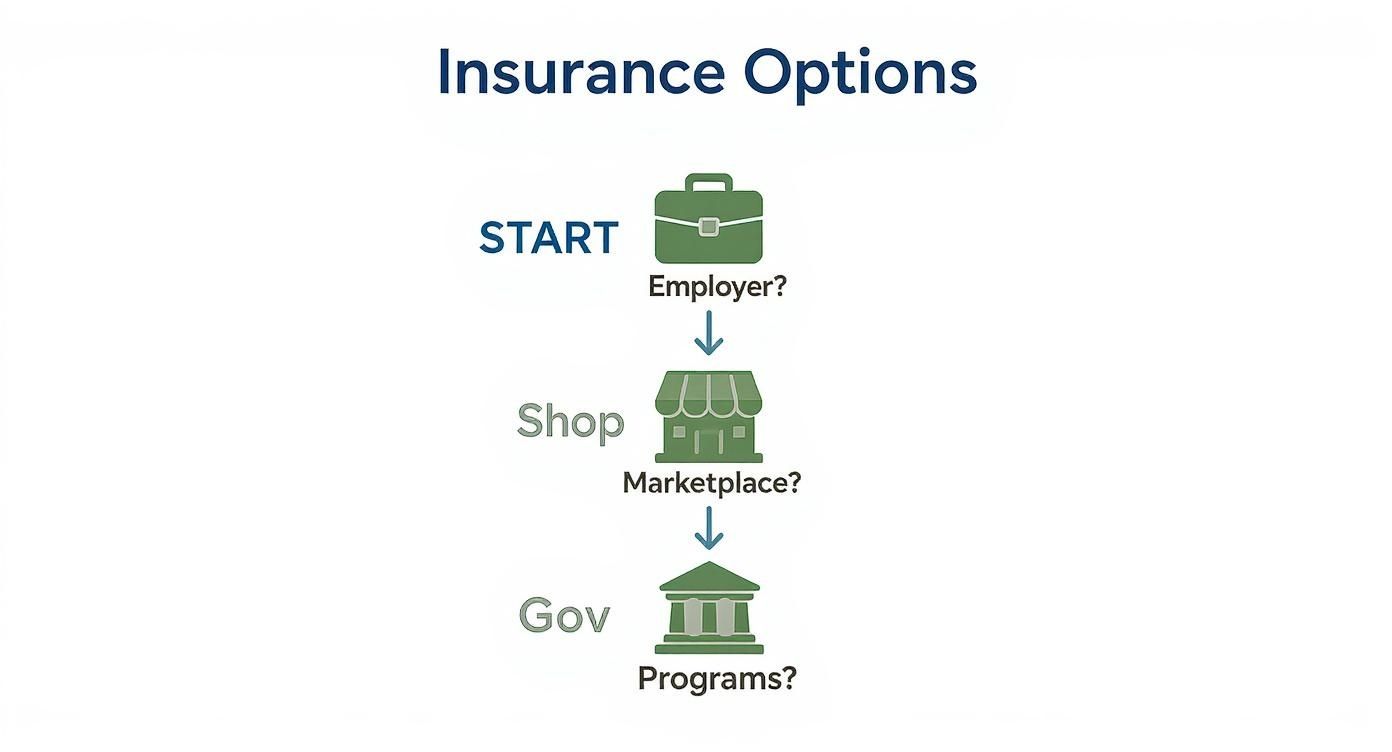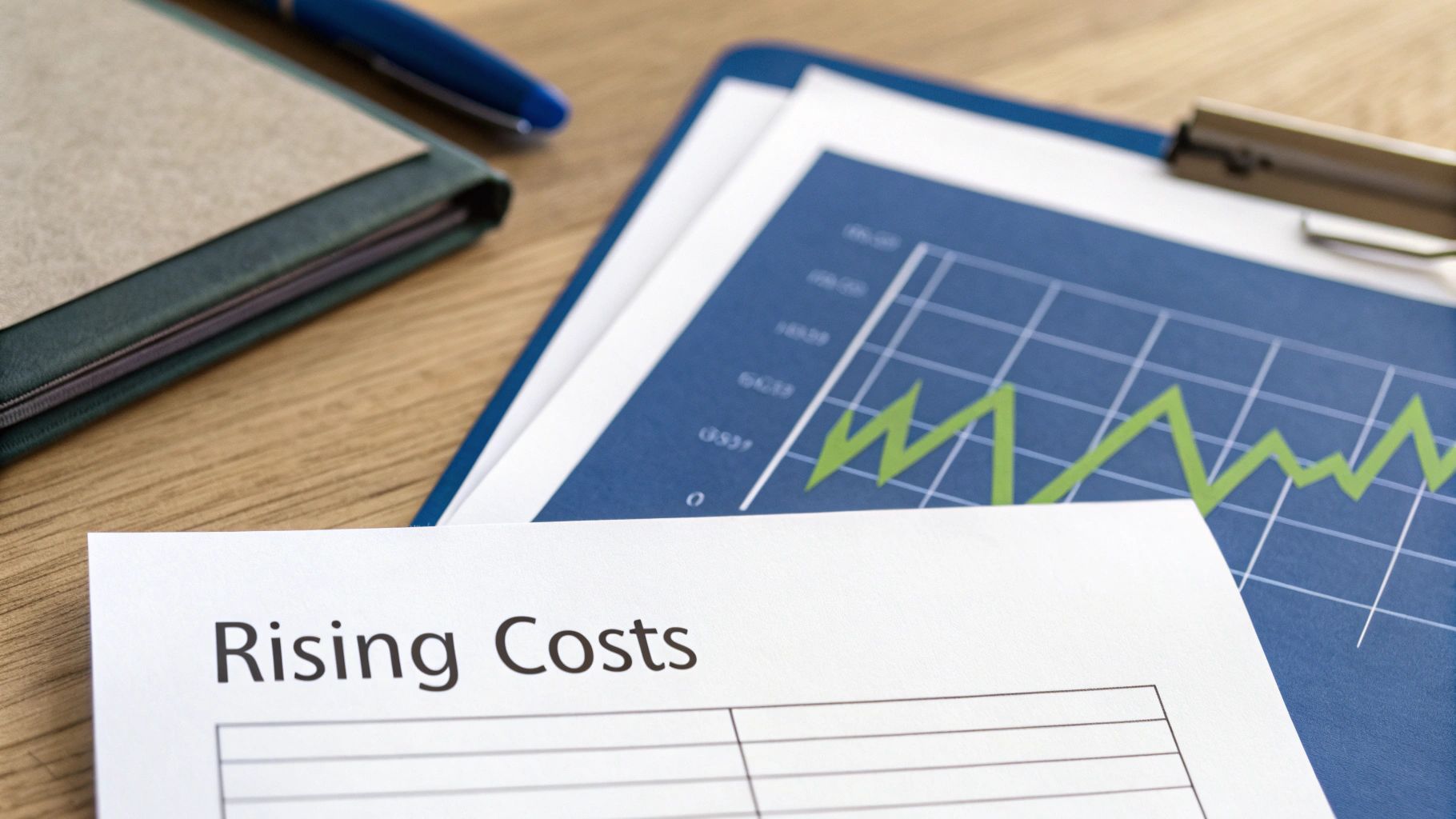For most people, the answer to the question "do I really need health insurance?" is a loud and clear yes. It’s easy to see it as just another monthly expense, but it’s much smarter to think of it as your financial shield—a barrier protecting your savings, your future, and your peace of mind from the crushing weight of an unexpected medical crisis.
Why Health Insurance Is a Financial Safety Net
If you only think about health insurance for routine check-ups, you're missing the big picture. Its real power kicks in when life throws you a curveball.
A sudden illness, a serious accident, or a life-changing diagnosis can trigger a tidal wave of medical bills, easily soaring into the tens or even hundreds of thousands of dollars. Without a health plan, every single one of those dollars is your personal responsibility.
This is where insurance steps in to be your financial backstop. It’s a simple trade: you pay a predictable monthly fee (your premium), and in return, the insurance company agrees to cover the lion's share of your medical costs if you get sick or hurt. This setup prevents one health emergency from completely derailing your life goals, like buying a home, saving for retirement, or putting your kids through college.
At a Glance: How Health Insurance Protects You
It can be tough to visualize just how critical this protection is until you’re in the middle of a crisis. This table shows a few common scenarios and how having a health plan changes everything.
| Scenario Without Insurance | How Health Insurance Steps In |
|---|---|
| A broken leg from a fall. You’re on the hook for the entire ER visit, X-rays, setting the bone, cast, and follow-up appointments. This could easily cost $7,500 or more, which you have to pay out-of-pocket. | Your plan covers a huge portion of the bills. After you meet your deductible, you’ll only pay a small copay or a percentage of the costs until you hit your out-of-pocket max. This turns a devastating bill into a manageable one. |
| An unexpected appendectomy. This common emergency surgery can cost anywhere from $10,000 to $35,000. Without coverage, that bill lands squarely in your lap, potentially wiping out your savings or forcing you into debt. | Insurance negotiates lower rates with the hospital and covers most of the cost of the surgery, anesthesia, and hospital stay. Your financial responsibility is capped at your out-of-pocket maximum, protecting you from the full, staggering cost. |
| A new chronic condition diagnosis like diabetes. You're now facing a lifetime of costs for insulin, monitoring supplies, and specialist visits. These ongoing expenses can add up to thousands of dollars every year, forever. | Your plan helps cover prescription drugs, regular doctor visits, and necessary medical supplies. Preventive care and management programs are often included, helping you stay healthier while keeping long-term costs under control. What would be a constant financial drain becomes a predictable, manageable expense. |
As you can see, health insurance isn't just for catastrophes—it makes ongoing and unexpected healthcare affordable, turning a potential financial disaster into a manageable event.
Understanding Your Role in Coverage
Even with a great plan, you'll still share some of the costs. This is actually designed to help keep everyone's premiums more affordable. You’ll hear a few key terms over and over:
- Deductible: This is the amount you pay for your medical care before your insurance plan starts chipping in. Think of it as your initial share of the costs.
- Copayments and Coinsurance: After you’ve met your deductible, you’ll pay either a flat fee (copay) or a percentage (coinsurance) for your doctor visits and treatments.
- Out-of-Pocket Maximum: This is the absolute most you will have to pay for covered medical care in a single year. Once you hit this number, your insurance pays 100% of all covered costs. It’s your ultimate financial safety net.
The real purpose of health insurance is to trade an unknown, potentially devastating medical bill for a predictable, manageable monthly premium. It’s a tool for financial security and genuine peace of mind.
While the federal requirement to have health insurance is no longer in effect, the financial logic for having it has never been stronger. To get a deeper dive into the legal side of things, you can learn more about if health insurance is required in our detailed guide. Ultimately, choosing to get covered is a proactive way to guard your financial well-being against whatever life decides to throw your way.
The Real Financial Dangers of Being Uninsured
Let’s be honest. Asking "do I need health insurance?" can feel like a far-off, abstract question. That is, until you see the actual numbers.
Going without coverage isn't just a small risk; it's a high-stakes gamble with everything you've worked for. One unexpected trip to the ER—a sudden appendicitis or a bad car accident—can easily leave you with bills bigger than the price of a new car. It happens that fast.

And this isn't a problem in just one country; it's a global crisis. By 2021, an estimated 2 billion people were facing serious financial trouble because of healthcare costs. A stunning 1 billion of them were hit with catastrophic levels of out-of-pocket spending.
This shows just how quickly medical debt can spiral out of control when you don’t have a safety net.
How Insurance Protects Your Wallet
So, how exactly does health insurance shield you from this? Let’s break down a few key terms. Think of your health plan as a cost-sharing deal between you and your insurer, one with a built-in "emergency brake" for your finances.
- Deductible: This is the amount you agree to pay first before your insurer’s money kicks in. If your deductible is $1,500, you’ll cover the first $1,500 of your medical bills for the year.
- Out-of-Pocket Maximum: This is your absolute financial ceiling. Once your spending hits this number, the insurance company pays 100% of all covered services for the rest of the year. It's the ultimate firewall against a six-figure hospital bill.
Without this protection, you’re on the hook for the entire, uncapped amount. A simple three-day hospital stay can average over $30,000—a cost that could wipe out years of savings in an instant.
The True Cost of a Medical Emergency
It's a harsh reality, but medical debt is the #1 cause of personal bankruptcy. It doesn't just hit people with long-term illnesses; it often strikes perfectly healthy people who figured they could get by without coverage. One bad day is all it takes.
Just look at these common—and shockingly expensive—scenarios without insurance:
- Emergency Appendectomy: $10,000 – $35,000+
- Setting a Broken Leg: $7,500+
- Heart Attack Treatment: $760,000+
The point of health insurance isn't just to cover the sniffles and routine check-ups. It's to protect you from that one random event that could bankrupt you, keeping both your health and your financial future safe.
This isn't about being negative; it's about being prepared. The financial dangers are simply too great to ignore. For a deeper look at what can happen, our article on medical emergencies without insurance offers some critical insights.
Having a plan in place means you're ready for the worst, even while you’re busy living your best.
Finding Your Way to Health Insurance Coverage
The world of health insurance can feel like a maze, full of confusing terms and endless hallways. But once you understand the layout, finding the right path to getting covered is more straightforward than you might think. Your goal is to find the right entry point based on your life, your job, and your budget.
Think of the options as different doors into the same building—the building of financial protection and well-being. Each door is designed for a different person, but they all lead to the same destination: peace of mind and access to the care you need, when you need it.
Employer-Sponsored Plans
For most people, this is the front door. The most common and often most affordable route to getting health insurance is through your job. If your company offers a health plan, they usually pay a big chunk of the monthly premium, which makes it a fantastic deal for you.
These are typically group plans, which means the insurance company spreads the risk across all the employees. This helps keep costs down for everyone. If you have this option available, it's almost always the best place to start.
The Health Insurance Marketplace
What if you're self-employed, a freelancer, or work for a company that doesn't offer benefits? This is where the government's Health Insurance Marketplace comes in. It's an online shop created by the Affordable Care Act (ACA) where you can compare and sign up for individual health plans.
One of the biggest perks of the Marketplace is the financial help available. Depending on your income, you might qualify for:
- Premium Tax Credits: These directly lower how much you pay for your premium each month.
- Cost-Sharing Reductions: These reduce your out-of-pocket costs, like your deductible and copayments, when you actually get care.
These subsidies can make a really solid, comprehensive plan surprisingly affordable. Never just assume you can't afford coverage without checking what you're eligible for first. It can be a little tricky figuring out which plan is best, so learning how to choose the right health insurance is a vital part of the process.
Government Programs
For certain groups, the government provides health coverage directly. These programs are an essential safety net that protects millions of Americans.
- Medicaid: This program gives free or low-cost health coverage to eligible low-income adults, kids, pregnant women, seniors, and people with disabilities. The rules on who qualifies can change from state to state.
- Medicare: This is the federal health insurance program mainly for people who are 65 or older. It also helps cover some younger people with long-term disabilities and those with End-Stage Renal Disease.
Finding the right path to health insurance is all about matching your personal situation—your job, your income, and your age—to the system that was built to serve you. Each option exists to make sure everyone has a way to get protected.
Other Niche Options
Beyond these main routes, a few other plans exist for specific situations. Short-term health insurance, for instance, can offer temporary coverage if you have a gap between jobs, but be careful—they aren't ACA-compliant and often won't cover pre-existing conditions.
It's also worth remembering that even with insurance, you need a trustworthy provider. Sometimes, people run into issues with insurance bad faith claims, where an insurer doesn't hold up its end of the bargain. This reality makes choosing a reliable, comprehensive plan from the start all the more important.
When Can You Go Without Health Insurance
Let’s be honest. While the answer to "do I need health insurance?" is almost always a resounding yes, there’s a tiny sliver of situations where you might consider going without it. This isn't about finding a clever loophole—it's about a cold, hard look at your finances and your tolerance for massive risk.
Deciding to skip coverage is a huge gamble. It's a path only worth considering in the most specific and narrow of circumstances.
The main scenario? You have a massive, easily accessible pile of cash set aside just for a medical crisis. I’m not talking about your 401(k) or the equity in your home. This means having enough liquid cash on hand to absorb a catastrophic bill without even flinching, let alone derailing your entire financial future.
Before you even entertain the thought, you need to be brutally honest with yourself about your true tolerance for risk. A single car accident or a sudden illness can easily rack up bills north of $100,000. The financial shockwave from something like that can haunt you for years, tanking your credit and putting your life goals on hold indefinitely.
This decision tree gives you a visual of the standard, recommended paths for finding coverage—which, for nearly everyone, is the right way to go.

As you can see, the secure and responsible options all lead back to having a structured plan in place. It’s just the smarter move.
A Cautious Self-Assessment Checklist
Still thinking about it? You need to be able to answer a firm and immediate "yes" to every single one of these questions. If you hesitate on even one, going uninsured is not a safe or realistic option for you.
- Financial Stability: Can you write a check for $50,000 tomorrow to cover an ER visit and major surgery without taking on debt or selling off important assets?
- Ongoing Care: If you were suddenly diagnosed with a chronic illness like diabetes, do you have the cash flow to cover thousands of dollars in prescriptions and specialist appointments, every year, for the rest of your life?
- Risk Tolerance: Are you genuinely prepared to negotiate directly with a hospital and potentially liquidate your life savings to cover a bill that could easily hit six figures?
- Access to Care: Do you understand that without insurance, many doctors and hospitals may demand large payments upfront before they even treat you for non-emergencies, which could delay critical care?
Choosing to go uninsured means you are personally accepting 100% of the financial risk for every possible health outcome, from a sprained ankle to a life-threatening disease. It is a decision that should never be taken lightly.
For the vast majority of us, the predictable monthly cost of a health insurance premium is an incredibly wise investment when weighed against the unpredictable, and potentially bankrupting, cost of a medical catastrophe.
Understanding the Rising Cost of Healthcare
Ever wonder why the question "do I need health insurance?" feels so much more urgent these days? The short answer is simple: the cost of getting sick is climbing, and it's not slowing down.
Paying for medical care out-of-pocket used to be manageable for minor things. But today, it’s becoming an impossible gamble. To really get why insurance matters so much, you have to look at the powerful forces pushing healthcare prices through the roof.
This isn’t just about one hospital charging more or a specific surgery getting pricier. It’s a massive, system-wide trend. Every year, incredible new medical technologies and life-saving prescription drugs hit the market. They work wonders, but they also come with a serious price tag. On top of that, as people live longer, the demand for complex, long-term care keeps growing, putting even more strain on the system.

What’s Pushing Medical Bills Higher?
Let's break down the key factors that contribute to the ever-increasing price of medical care. This table shows what's driving costs up and how insurance acts as your financial shield against them.
| What Drives Rising Healthcare Costs |
| :— | :— | :— |
| Cost Driver | Its Impact on Your Medical Bills | Why Insurance Is Key |
| Advanced Medical Technology | Lifesaving tools like robotic surgery and targeted therapies cost a fortune to develop, pushing procedure prices sky-high. | Insurance negotiates lower rates and covers a large portion of these high-tech treatments, making them accessible. |
| An Aging Population | Older individuals naturally need more frequent and complex healthcare, increasing overall demand and straining resources. | By spreading risk across a large pool of people, insurance keeps the system stable and affordable for everyone. |
| Higher Prescription Drug Costs | The research, development, and marketing of new drugs mean that the price for vital medications continues to soar. | Prescription drug plans included in health insurance can dramatically lower your out-of-pocket costs for necessary medicine. |
These trends show no signs of stopping. Global medical costs are expected to jump by another 10.4% in 2025 alone, a rate that’s become frighteningly normal. To get a better handle on the bigger economic picture, it’s worth looking into the government's spending review on healthcare.
Understanding these rising costs is key. It helps reframe health insurance not as an expense, but as a financial tool designed to shield you from a volatile and expensive market.
When you see the numbers, trying to self-fund your healthcare feels less like a choice and more like a massive financial risk. A predictable monthly payment, known as a premium, is the smart way to protect yourself.
This is how insurance turns an unpredictable, potentially catastrophic expense into a manageable, budgeted cost. If you want to dive deeper into how that monthly payment works, our guide on what is an insurance premium breaks it all down.
Frequently Asked Questions About Health Insurance
Trying to make sense of health insurance can feel like a puzzle. Let's clear up some of the most common questions people have when figuring out if they need it and how to get it.
I'm Young and Healthy. Do I Really Need Insurance?
Yes, and here’s why: think of it less as "sick insurance" and more as "what if" insurance. While you might feel invincible now, life has a way of throwing curveballs. An unexpected accident or a sudden illness can happen to anyone.
A single broken bone from a slip on the stairs could easily rack up tens of thousands of dollars in emergency room bills. Health insurance is your financial safety net for that one bad day that could otherwise wreck your finances for years.
What Is the Cheapest Way to Get Covered?
There’s no single "cheapest" way—it all comes down to your life situation. But there are a few main paths to finding affordable coverage.
- Employer-Sponsored Plans: If your job offers health insurance, this is almost always your best bet. Employers usually pay a big chunk of the monthly premium, making it a fantastic value.
- Medicaid: If you have a low income, you might qualify for Medicaid, which offers free or very low-cost health coverage. The rules change from state to state, so you'll want to check your local requirements.
- The Health Insurance Marketplace: This is the go-to for anyone who is self-employed or doesn't have insurance through work. Depending on your income, you could get tax credits (subsidies) that dramatically slash your monthly premiums and make a great plan surprisingly affordable.
Can I Be Denied Coverage for a Pre-existing Condition?
Nope. Thanks to the Affordable Care Act (ACA), insurance companies can't deny you coverage or charge you more just because you have a pre-existing condition like asthma, diabetes, or anything else.
This is a huge deal. It means you can get the health insurance you need without being penalized for your medical history.
This protection is one of the most important parts of modern health insurance. It ensures coverage is there for the people who need it most—those already managing a health issue.
When Can I Sign Up for a Health Plan?
You can't just enroll whenever you feel like it. Health insurance enrollment is usually restricted to specific times of the year.
The main window is the annual Open Enrollment Period, which happens every fall. This is when anyone can sign up for a new plan or make changes to their current one.
But life doesn’t always follow a calendar. If you go through a Qualifying Life Event, you get a Special Enrollment Period. This gives you a 60-day window to get a new plan outside of the normal timeframe.
Common qualifying events include:
- Losing your health coverage from a job
- Getting married or divorced
- Having a baby or adopting a child
- Moving to a new zip code or county
Knowing these rules helps you make sure you never miss your chance to get covered when life changes.
Navigating all of this can feel complicated, but you don't have to figure it out alone. The experts at My Policy Quote are here to help you understand your choices and find a plan that fits your life and your budget. Explore your health insurance options with us today!


